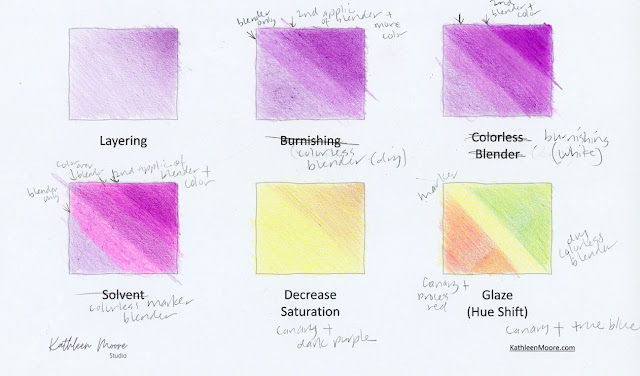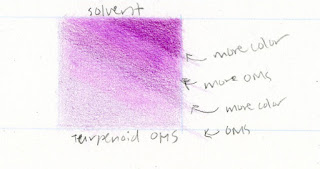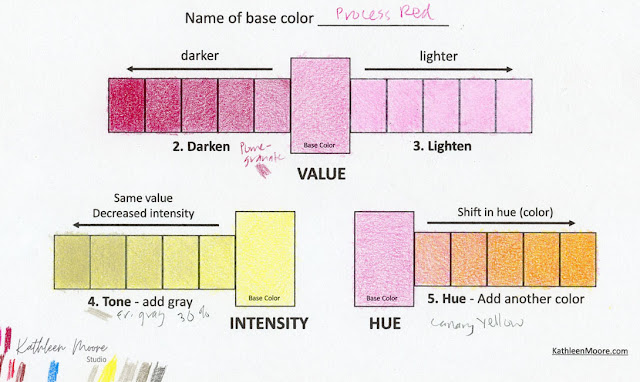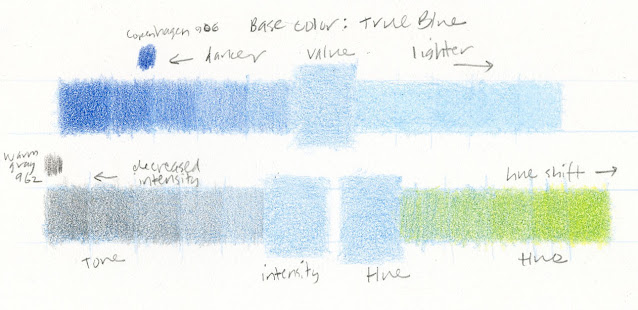 |
| 5/25/21 Prismacolor pencils on Stonehenge White |
Learning to draw trees with graphite from Kathleen Moore
a few months ago was both informative and inspiring. When I heard she would be
offering a new class in drawing nature with colored pencils, I was interested,
but what made me sign up was that we would be drawing from life, not photos. Although
I had gained a solid foundation in drawing with colored pencils when I studied with Suzanne Brooker several years ago, we worked entirely from
photos then. We drew from real plants in Crystal Shin’s botanical workshop,
but there wasn’t much time in a weekend to sink our teeth into small studies.
I’m excited about this five-week Gage course with Kathleen and doing some
deeper teeth-sinking.
Week 1’s lessons were on the basics of making and blending
marks with the colored pencil medium. Much of this was review for me, but what
was new was using various types of blending materials, which I have dabbled with on my own but hadn’t learned to use formally. The purpose of all these blending
materials, I learned, is to freshen the surface of previously applied pigment so that more
layers of pigment can be added without flattening the paper’s tooth. (I don’t think I was using them properly before, as they seemed to flatten the tooth in my previous experiments.) If more
than one color has been used, they also blend the pigments.
Edited: After today's class, I understood more about blending materials, and I misstated part of the paragraph above: Solvent is the only material that will blend pencil pigments without flattening the paper's tooth so that more color can be applied afterwards. That is why many colored pencil artists use it. Dry materials like white pencil and colorless pencil will flatten the tooth.
The materials we are using are a Prismacolor colorless
blending pencil, a White Prismacolor as a burnishing/blending tool, and a
solvent (Kathleen had suggested odorless mineral spirits called Gamsol, but I
couldn’t find it in a small bottle, so I’m using the similar Turpenoid). In
addition, I happened to have a Prismacolor colorless blender in marker form
(which can be used to blend both colored pencils and alcohol-based markers), so
I gave that a shot, too.
Kathleen recommended Prismacolor pencils for this class. My
worksheet below is messy because I used the wrong materials in the labeled
boxes, but you can see the results of my experiments. The White pencil gave the
smoothest blending results, but the dry colorless blending pencil was the
easiest to apply and control. I didn’t like using the colorless marker at all
because it altered the hue significantly. The first four squares were all made
with the same Prismacolor Dark Purple, but the colorless marker turned the
color bright pink.
 |
| Worksheet using various blending tools (printer paper) |
 |
| Turpenoid solvent (Stonehenge hotpress) |
The worksheet above was done on basic printer paper, which
has a terrible surface for use with colored pencils. For my last sample using
Turpenoid (left), I wanted a heavier paper, so I made that one on Stonehenge Hotpress,
which has a much better surface for colored pencils. Although I generally avoid
using toxic solvents, I wanted to try the odorless mineral spirits to see how
it compared with the other options. I’m sure my technique is lacking, but I
wasn’t impressed with its blotchiness. I don’t see a compelling reason to use a
poisonous substance when benign, potentially better options are available (like
the colorless pencil), but I’m keeping my mind open to see how Kathleen uses
it.
Another lesson from Week 1 involved making worksheets to
change the value, intensity and hue of a pencil color. I made my first
worksheet using Process Red and Canary Yellow as base colors on printer paper.
Again, I hated applying colored pencil pigment to that paper (and I also
realized too late that I was supposed to do all three exercises with the same
base color; apparently reading directions is not in my skill set!), so I made a
second worksheet with True Blue as the base color, and this time I used
Stonehenge Hotpress paper.
 |
| Printer paper |
 |
| Stonehenge Hotpress |
For both value exercises, we were to use a darker shade of
the base color applied in increasing layers to darken the base color; we were
to use a White Prismacolor applied in increasing layers to lighten it. On
either type of paper and for both Process Red and True Blue, I found the White
Prismacolor to be ineffective at lightening the hues. I don’t know what I’m
doing wrong, but I saw no difference in the tone, no matter how many layers I
applied. The White pencil just isn’t opaque enough.
For the intensity exercises, the assignment was to find a
gray of the same value as the base color and use it to decrease its intensity
with increasing layers of the gray. The challenging part was identifying a gray
of the right value. (She recommended using a grayscale attached to a color
wheel, which I have somewhere . . . . I’ll have to dig it out.)
Week 2’s assignment was to make a simple still life with a
few rocks (top of post) and apply the techniques we learned from the Week 1
exercises. I admit, I am typically not too excited about drawing rocks, but I was
thrilled by this assignment! It made such a difference to be drawing from life
instead of a photo. Once I started observing the rocks closely, I became
fascinated by all the subtle colors I could see. I ended up choosing nine,
which might be too many for a small drawing, but I enjoyed practicing blending
the various hues.
 |
| The nine Prismacolor colors used in the still life |
I tried using the White Prismacolor to lighten areas (such
as the barely distinguishable highlights), but as with the worksheet exercises,
I found it to be ineffective. I liked the subtle texture imparted by Stonehenge White paper for these rocks. In the case of cast shadows, however, I wanted
to remove the specks of paper showing through. Easy to apply even in small
areas like the top rock’s slender cast shadow, the Prismacolor colorless
blender pencil was especially effective for that. It was also effective in
blending colors evenly. I think it’s a keeper in my colored pencil tool box.
 |
Part of the assignment was to photograph the still
life from an angle as close as possible to the one from which
it was viewed to aid critique discussion.
We are drawing from life, which makes me so happy! |
Incidentally, although I’m tired of Zoom, Kathleen is an
excellent online instructor. Using multiple cameras, she videorecords her demos
in advance so that students can view them at their convenience, repeat
sections, slow them down or speed them up as needed. Then we meet on Zoom for
live critique and discussion. I’m eager to get back into the Gage classroom
whenever it becomes safe to do so, but the one thing I’ll miss about virtual
learning is being able to see demos easily and clearly, which is not possible
when peering around other students or over the instructor’s shoulder in a
classroom.



















































